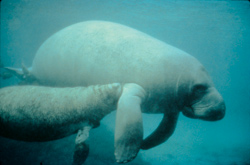| Researchers
Team Up On Manatee Protection System
downloadable
pdf
Manatees
and boaters, two groups perpetually at odds, might soon
find themselves on the same wavelength, thanks to the
equivalent of the manatee pick-up line.
 Because
the placid sea cows flock to shallow water and swim
slowly, averaging 3 to 5 miles per hour, they are particularly
susceptible to collisions with boats. Such hits are
the main cause of manatee deaths in the United States.
Many others suffer severe cuts and other injuries. Because
the placid sea cows flock to shallow water and swim
slowly, averaging 3 to 5 miles per hour, they are particularly
susceptible to collisions with boats. Such hits are
the main cause of manatee deaths in the United States.
Many others suffer severe cuts and other injuries.
Now
UF researchers from the colleges of Veterinary Medicine
and Engineering have developed a sophisticated acoustical
system to assess how manatees react when vocalizations
from their brethren are taped and played back on underwater
speakers. Preliminary results show the technology has
the potential to accurately pinpoint manatees’
locations. That could lead to devices that would signal
boaters that manatees are present, allowing them to
adjust their speed as needed. Currently, slow-speed
zones — a source of frustration for many boaters
— are fixed in Florida waterways where manatees
reside.
Deke
Beusse, director of UF’s Marine Mammal Medicine
Program, and Chris Niezrecki, an assistant professor
in the College of Engineering who directs one of the
college’s acoustics laboratories, are fine-tuning
their methodology at Florida locations such as Blue
Springs and Homosassa Springs State Park where many
of the animals live in quasi-captive conditions. The
researchers are documenting how the mammals react when
vocalizations from other manatees are played to them
via underwater speakers. The manatees’ calls are
somewhat of a cross between a squeaky swing and a shrill
chirp.
“We
have found that animals vocalize more than originally
thought in a quasi-captive environment,” Beusse
said. “We’ve also found that they increase
vocalizations when the sounds of other manatees are
played back to them.”
Eventually,
the UF team hope its technology will be able to pick
up the sounds manatees make through the use of hydrophones
located in the channels of heavily used waterways. As
soon as sounds are detected, broadcast vocalizations
would immediately cease so that manatees wouldn’t
suddenly head toward boat traffic.
“Then
by alerting boaters, either through a blinking light
or a radio signal, we could let them know where the
manatees are, so that they can slow down or continue
at normal speeds if manatees aren’t in the area,”
Beusse said.
The
project began with a $15,000 grant from the Florida
Legislature and has continued with $215,000 from UF’s
Marine Mammal Medicine program.
Although
research has been conducted on manatee vocalizations
in the past, never before have scientists attempted
to evaluate the effects of broadcasting sound to manatees,
Beusse said.
“Scientifically,
the UF project is significant because it raises questions
about how manatees hear and at what frequencies they
are able to detect sound,” Beusse said.
The
next phase of the UF team’s work will involve
testing in a large area within the Indian River on Florida’s
east coast. Researchers will then attempt to determine
from what distance the manatee sounds can be detected
and from what distance manatees can distinguish other
manatee sounds.
“Then
we will work out the technical aspects of warning boaters
with lights, radio and through depth finders,”
Beusse said, adding that, theoretically, various state
agencies would determine the best locations for using
the devices.
by
Sarah Carey
|

